
A PERFECT DAY
| |
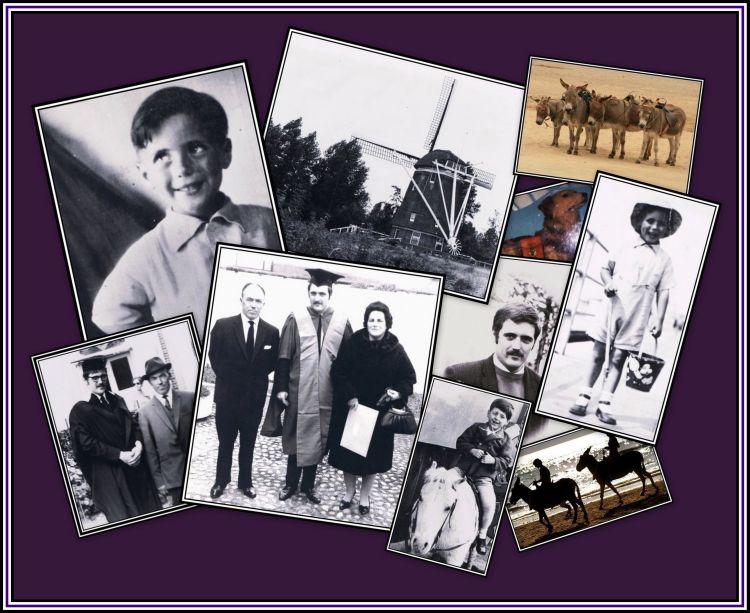
|
Click on the collage to hear another version of A Perfect Day |
|
| |
 |
| |
| Once we left London to live in Langley in 1956, I did not go back to Dalston for a number of years. In fact it wasn’t until 1964 that I paid a visit to the Ridley Road Market. For some unknown reason, I did not take the little red bus, but got there by bus from Liverpool Street. By now, the trolley bus was a thing of the past with the routes being renumbered and Routemasters taking them over. I was showing the area to a friend of mine, who had not had the good fortune to be born in the East End of London. I remember seeing that the Plaza had closed. Although the shell of the building was still present, its frontage had been altered during its conversion back into a shop. At that time, Oxfam occupied it. I noticed that the upper floor had become a Snooker Hall. Snooker Halls seemed to be everywhere at this time. The Standard cinema, just off Hackney Road and the ABC on the corner of Well and Mare Streets, were also being used for such purposes. For some unknown reason, we did not go into the Oxfam shop, but made our way up to the market. Naturally I regret this now, as I would have liked to see if anything remained of the old cinema. |
| |
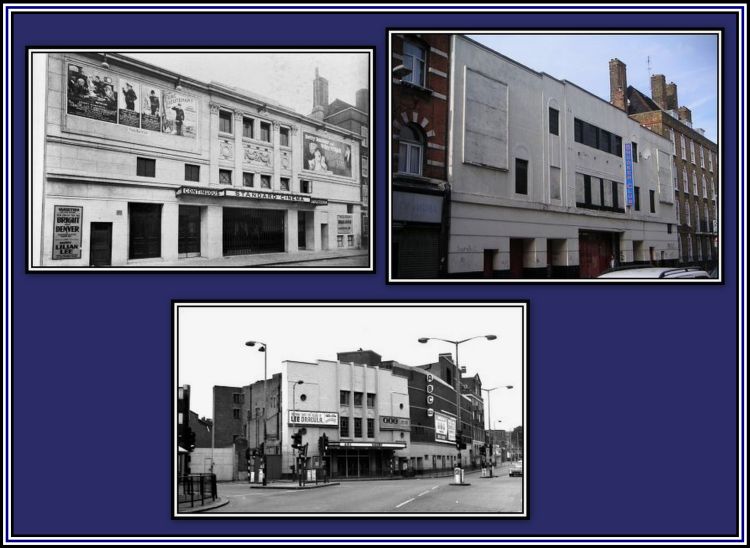 |
Top row: Standard London Fields, as a cinema (left) & as a snooker hall (right)
Bottom row: ABC Well & Mare Streets, as a cinema |
| |
| I was pleased to see that Cooke’s, the pie ‘n’ mash shop was open for business and that live eels were still for sale through one of the front windows. We went inside and I ordered two pie ‘n’ mash, no liquor, twice please. We took up our spoon and fork out of the container at the end of the counter and waited for the server to give us our food. Pie shops never offered knives for some reason. I remember asking my mother the reason for this. According to her, at one time the clientele were considered far too dangerous to be given knives. On Friday and Saturday nights when they were the worse for drink, arguments often broke out and one could not risk having one customer plunging their knife into another in order to ram home a point. This explanation made perfect sense. |
| |
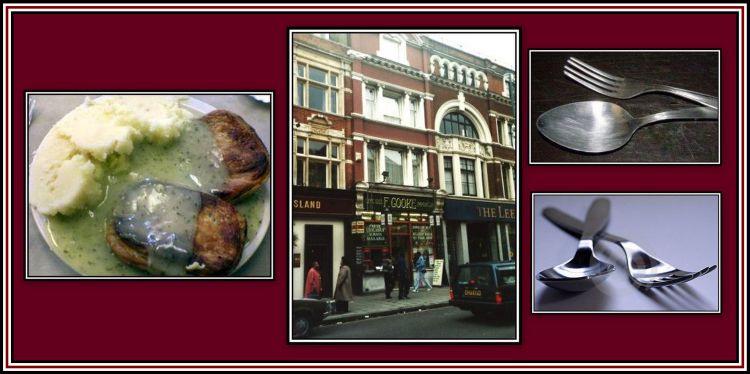 |
| |
The forms were still present as were the marble top tables in the shop and sawdust was still used on the floor. Although the pies were tasty, they were nowhere near as delicious as those of my father’s. One thing that was evident about these pies, they cost a great deal more than they did when I was a kid.
Although the Ridley Road Market looked as it did, it had changed somewhat. Unfortunately, I could not find a butcher shop sold Saveloys and Peas Pudding. This was a great disappointment to me, as I had been looking forward to re-sampling this delicacy. However, I was pleased to see that the various gizzards and innards were still for sale together with huge trotters and some very strange looking fish that I did not remember seeing for sale when I was a kid. The fish ‘n’ chip shop was now under new management and no longer sold anything that interested me. However, my greatest disappointment came when I visited the Bagel Shop. Although it was still a bakery, it was now decidedly more up market and sold a variety of Americanized bagels. Prepared bagels were also available with your choice of cream cheese with or without locks. |
| |
 |
| |
When we came out of the bakery, we were greeted by a group of young women singing hymns. I was informed by a passerby that they were not part of The Salvation Army, but members of a new evangelical church that had moved into the area recently. They sang nicely and gratefully accepted my donation. Sadly, no barrel organ was seen in the market that day.
|
| |
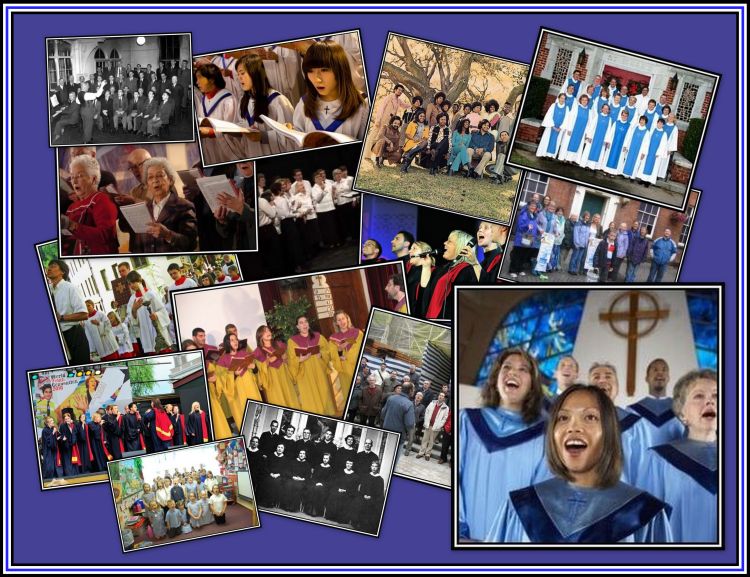 |
| |
| When we reached the bottom of the market, we walked to the bus stop and waited to see what kind of bus was on the 236 route. I was pleased to see that it was still a red single decker RF. |
| |
 |
| |
|
| |
| When my father had died in 1989, it was decided that my mother would move and live with me for the remainder of her life. It wasn’t until 1992, when I moved to Chapel Hill, North Carolina that she made the move. She managed to settle into her new life, but naturally missed her old home and England. We had brought over a number of things so that her bedroom resembled as much as possible her room in Langley. In 1994, I returned to Langley to collect a few additional things that a friend had kept for us until we were ready to come for them. |
| |
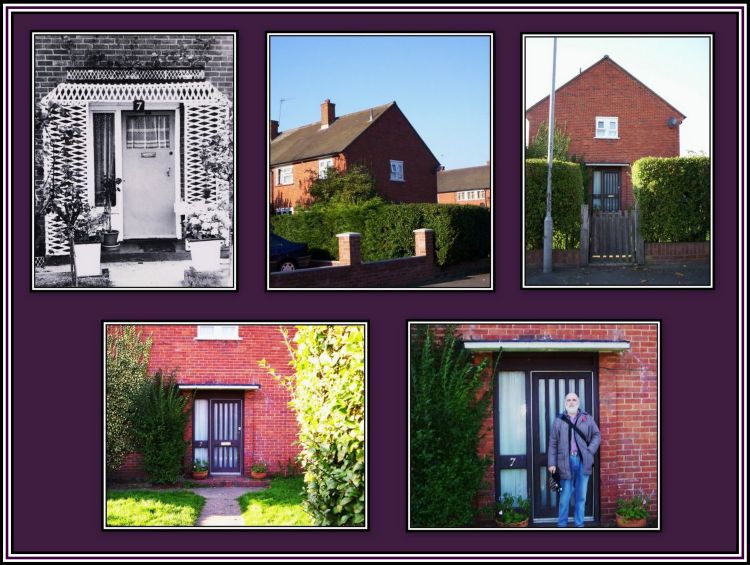 |
Langley 1956 & 2006 |
| |
While in England, I decided that this would be a good time to take some photographs of places that my mother liked. As I have said, when I went to photograph the Excelsior cinema, I was too late as it had been demolished several years earlier. I also thought that she would enjoy having some photographs of the Ridley Road Market and so I took a sentimental journey there by the route that my mother and I used to take when I was a child.
Sadly, the 653 route was no longer serviced by a trolleybus, but had long since become the 253 route and was now serviced by a Routemaster. I took the bus at Aldgate and got off at The Triangle at the junction of Mare and Westgate Streets. I was pleased to see that the old horse and cattle trough was still there and had not been removed in the name of progress. What was interesting was that the trough now contained flowers in place of water. |
| |
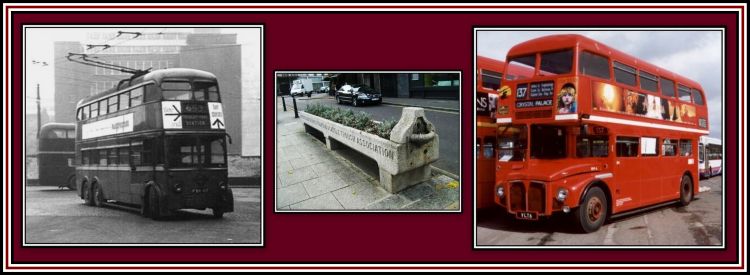 |
| |
One great difference to the area that was markedly noticeable compared to the days of my childhood was the lack of scent in the air. I learned that the scent factory had closed some time earlier and so the air was no longer filled with its fragrance. Now the air smelt only of car fumes and an occasional blocked drain. Although the factory has long since gone, I felt sure that hidden amongst the perfumes of today, I could still sense that scent in the air from years gone by.
I walked along Westgate Street and came to London Fields. Before me was the Broadway Market, which looked a little busier on that Saturday morning than how I remembered it from when I was a child. I walked the length of the market, as we used to do and noted that the place was now decidedly more up market. The area was undergoing the start of gentrification. Several of the old public houses had already been converted into wine bars and restaurants. The sale of British beer in London was in decline. Lager and wine were growing in popularity. Budweiser was now on sale in most public houses. Alas, I had noticed that the breweries where I had grown up – Mann, Crossman & Paulin's, Charrington’s, Truman’s and Watney’s – had been closed and their buildings demolished, used for different purposes or left derelict. |
| |
 |
Top row, left & middle: Mann, Crossman & Paulin's Brewery
Seceond row, left & middle: Charrington's Brewery
Third row, left & middle: Truman's Brewery |
| |
| One good thing about the Broadway market was that Kelly’s, the pie ‘n’ mash shop was still open for business and seemed to be as successful as ever. Just across the road from Kelly’s was the canal. It was remarkably quiet without any barges and horses, I was sorry to say. |
| |
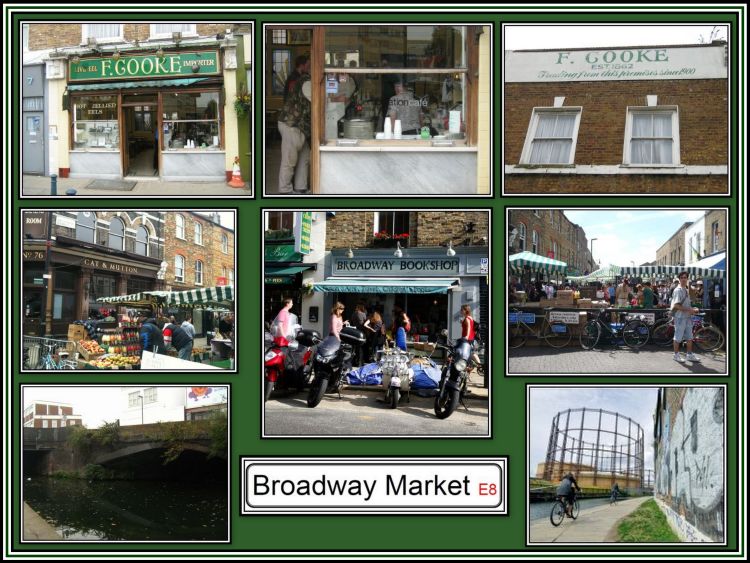 |
| |
I made my way back to the entrance to London Fields and waited for the bus to come. I was intrigued to find out what kind of bus would be coming. As I said before, I am the victim of an over-active imagination and guilty of a number of misconceptions regarding the journey from London Fields to Queensbridge Road as the reader will now learn.
The bus was a single-decker, but unfortunately it was no longer a Crockle Bus or an RF. It was now a one-man operated single-decker bus in red livery made by Volvo. The bus had few seats and most of its inside space was given over to standing room. I remember that the bus was filled with retirees, each of which had brought their shopping trolley with them, which would later be filled at the market. As a result, the standing space was greatly reduced. |
| |
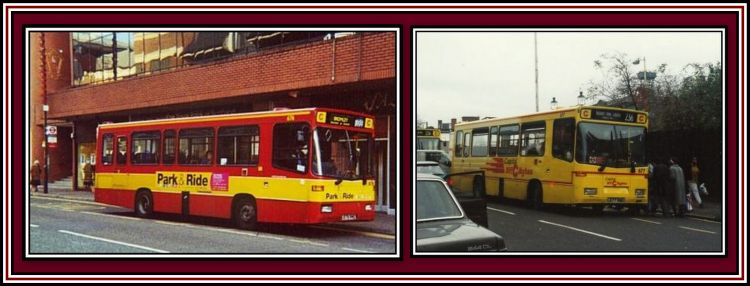 |
| |
Once I stepped inside, the bus immediately took off at a fast speed and I found myself swaying as the modern suspension kicked into gear. Immediately, as we whizzed along the street, I noticed that the old Victorian houses were no longer present. Apparently the whole area had been redeveloped and new housing had replaced the old poorly-maintained homes. What I also noticed, and surprised me somewhat, was that the Borough Council had not seen fit to modify the geography of the roadway through the area. As a result, the fast moving bus with its over-adequate suspension zigged and zagged around the bends just as the old Crockle bus used to in the past. Since the one-man operator insisted on almost flying through the streets, seated passengers were thrown from side to side while shopping carts began to move and then roll across of the bus, finally crashing into those standing. Meanwhile those standing held on to rails in the hope of maintaining some semblance of stability. Most of us were thrown from side to side with such an amazing force that I was surprised that we did not suffer dislocation of the shoulder.
In the distance I saw another pensioner waiting at a Request Bus Stop standing with an arm outstretched in the hope of stopping the bus. Once he was spied by our one-man operator, he suddenly jammed on the brakes and we screeched to a stop some ten feet past the stop. While the bus stopped, we, the passengers did not, and found ourselves continuing to be hurled forward. Those seated had the seat in front of them to impede their momentum while those of us that stood were not so fortunate and a number of us found ourselves being slung along the bus. A few, including myself, did not only perform a kind of soft shoe shuffle along the bus, but also found ourselves losing our footing and tumbling to the floor. Our illustrious one-man operator was not in the least bothered by the mayhem that his mode of driving had caused and once the new passenger had put one foot into the bus, he was off and running, leaving the weak and wounded to cope with the indignities that he had brought on them, as best they could. |
| |
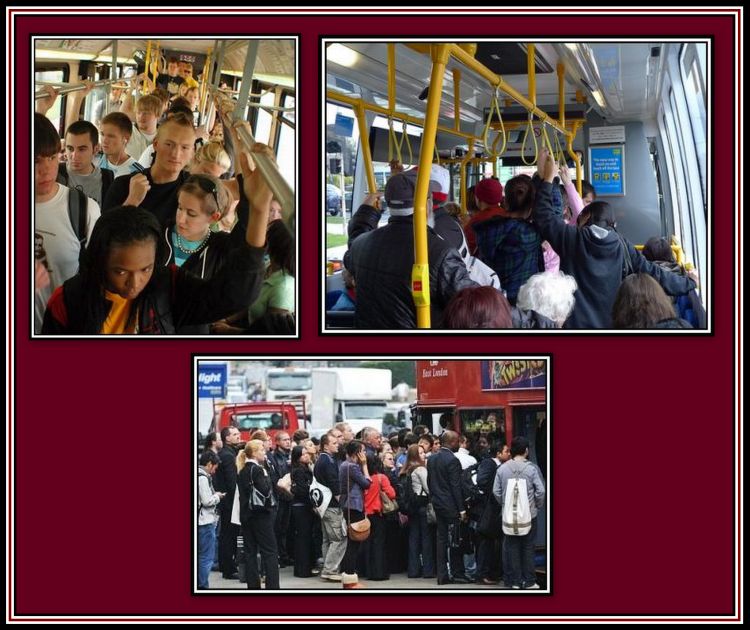 |
| |
Somehow I managed to get to my feet and after regaining my composure and after offering numerous apologies to those that I had collided with, I retook my place holding the bar, this time with both hands. As we continued to fly through the streets, I noticed that we passed over only one canal. The full force of this realization did not hit home at the time, as I was preoccupied with maintaining myself in an upright position.
Once we got to Queensbridge Road, a pensioner got off or alighted the bus, as this action was once described and a seat became free. I nodded to an old man to take it, but he declined saying that I needed it more than him! With some embarrassment, I accepted it and found the journey to be only slightly less uncomfortable.
While seated, I was able to think about the part of the journey that I had just suffered through. I suddenly remembered that I had only crossed one canal. This struck me as being odd since I distinctly remember crossing four canals when we took this journey when I was a child. |
| |
 |
| |
Perhaps one of the greatest misconceptions that I lived under was in my belief that the 236 passed over a large number of canals on its way to Queensbridge Road. Until this trip in 1993, I honestly believed that the bus passed over four bridges and four canals, as it made its way to Ridley Road. Evidently we now crossed over only one canal. I have to confess that I found my misconception to be somewhat surprising. At first, I assumed that the route had somehow been altered so as to avoid the other canals. However, after consulting a map I learned that there was no evidence that other canals existed, only the one. Obviously I must have imagined the others and exaggerated their number. I knew that this must be the explanation and that I had to accept this finding, but try as I might, deep down, and I have to be honest here, I was not altogether convinced. Even now, I have this sneaky feeling that perhaps – just perhaps – some alterations to the area must have been undertaken that somehow resulted in the loss of the other canals! This may seem unlikely but stranger things have happened, wasn’t I the only one to remember Dawson’s?
I breathed a sigh of relief when we finally got to our destination. I made sure to alight at the front of the bus, as I wanted to have a word with our hero, the one-man operator. He was a youthful person in a poorly kept uniform and without a tie and hat. I told him how I had been flung to the floor, whereupon he turned away and gave the impression that he had no interest in hearing how his inability to drive correctly had caused me both embarrassment and discomfort. After a minute, I could see that he was not in the least bit interested in my complaint, so I asked him for his number and told him that I was going to report him for dangerous driving. He shrugged his shoulders and turned to show me a button on his lapel that displayed his number. I did report him. I went to 55 Broadway, just off Victoria Street, which is the Head Office of London’s Buses. They took my information, but showed little interest and told me that I would be hearing from them, which of course I never did. |
| |
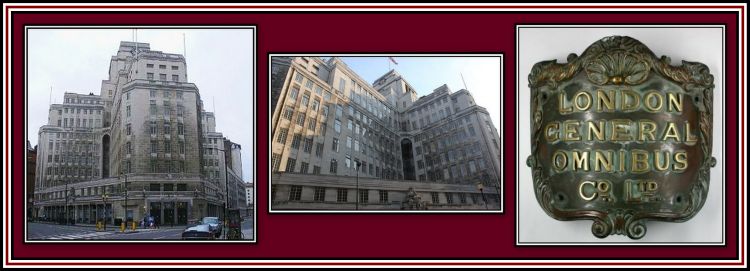 |
55 Broadway |
| |
Once I got off the bus, our glorious one-man operator flew off and was soon lost in the distance. I stood there and watched him go while I regained my composure. I was still confused by the journey. It had raised several unanswered questions: when the old housing had been demolished, why hadn’t the authorities straightened the roads to avoid the zigging and zagging that we had to suffer and what had happened to the other canals? Unable to come up with quick answers, I put these questions to the back of my mind and decided to go the Ridley Road Market and see what changes had occurred there.
At the 236 bus stop at the rear end of the Ridley Road Market is a church and a warehouse on either side of the bus stop. The warehouse was once owned by a Jewish company and Stars of David may be seen on the roof. |
| |
 |
| |
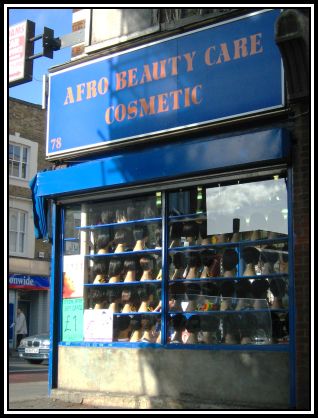 |
I made my way through the Ridley Road Market and soon discovered that oxtails, tripe and trotters were still for sale and that I was now able to recognize the strange looking fish in the shops that had puzzled me in years earlier. The bagel shop was as up market as ever, but I do have to admit that the cakes were as delicious looking as before. One new shop close to the bagel shop and which was not present in the past was a Wig Shop where all kinds of styles were displayed in the window. Across the way, some of the old shops had been demolished to make way for a shopping mall with entrances on both Ridley and Kingsland Roads. The mall contained the usual chain stores offering little to interest me.
I was pleased to find that there was still a gathering of singers in the market from one of the local churches. They sang well and deserved their donation. However, I did miss the Salvation Army Band and the barrel organ.
Kingsland Road was packed with people out to do their Saturday shopping. I noticed that the road was littered with a number of American fast food restaurants and each was packed with customers flowing out onto the pavement. I looked across the street and was somewhat dismayed to see that F. Cooke’s pie ‘n’ mash shop did not seem to be very busy. I crossed the street and went in and treated myself to a pie ‘n’ mash, which proved to be tasty. Sadly, the place was not full of customers and, even sadder, there were few young people present. Obviously the culinary tastes of the inhabitants of the area had changed and pies ‘n’ mash were competing poorly against hamburgers and French fries. |
|
| |
 |
| |
| Once I left the shop, I wandered along the Kingsland Road. The Oxfam Shop was now closed and the area had a decidedly miserable look. By now I had had enough of my trip down Memory Lane and went and caught a bus to Liverpool Street and modern times. |
| |
|
| |
|
| It wasn’t until 2009 that I returned to Dalston. I was going to find the Rio cinema in Dalston. I have to admit that I had never seen this cinema before. Somehow I had missed it. As I had been in Hackney, I had walked down Mare Street and over to London Fields and then took the 236 for sentimental reasons. As before, I found myself being flung about the bus, which now was a Dennis Dart SLF. Obviously the bus drivers of this route must enjoy racing through the neighbourhood to Queensbridge Road. |
| |
 |
| |
I was happy when the bus arrived at the foot of the Ridley Road Market so that I could get off. I was pleased to find the market was very much as it was during my last visit. However, I was in for a shock when I came to the Kingsland Road.
I could not believe my eyes when I came to the top of Ridley Road and looked across Kingsland Road. On the other side of the street, Cooke’s was no more. I was stunned. It had closed and was now a Chinese Restaurant. I stood and looked at the building in a shocked state. Mercifully the building was intact and did not look as if it had undergone any major changes. |
| |
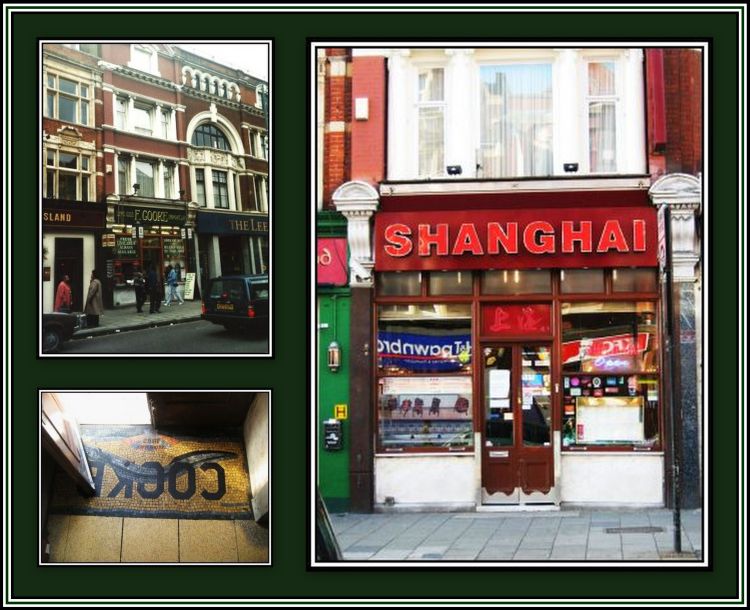 |
| |
As I said, I had come to Dalston specifically to find the Rio cinema and intended to do this now. However, once I left the restaurant instead of turning left I turned right and began walking in the direction of Dalston Lane. Before I realized my error I had arrived at the crossroads where Dalston Lane becomes the Balls Pond Road. Just as I was about to turn round and retrace my steps, something caught my eye, which would prove equally as devastating as my earlier surprise.
What had caught my eye now was something that sent me reeling for the second time that day. Actually, what caught my eye was not so much something, but rather nothing where something had once been! Just across the way, on the left-hand side of Kingsland Road was the site of the Plaza cinema. When it closed in 1959, the building was turned back into a shop with its upper level being converted into a snooker hall. The last time I visited the area, the shop and the snooker hall were closed and the whole building was unoccupied. Naturally I assumed that a new business enterprise would soon occupy the site, but I had not bargained for the changes that would soon face me.
What had sent me reeling was the seemingly absence of the shop that once was the Plaza Dalston. There now appeared to be a huge gapping nothingness where the building had stood. After gaining my composure, I crossed the Balls Pond Road and walked along the Kingsland Road. I wanted to get a look better at where the cinema once stood from a distance. The site was closed to the public by large blue wooden gates. On one of the gates was a notice, which the odd passerby was stopping to read, something I needed to do.
|
| |
 |
| |
 |
As the traffic on the Kingsland Road was busy, I had to walk back to the crossroads and wait for the traffic lights to change before I could get across the road and make my way along to the gaping space that now occupied the site where once so much time of a perfect day was spent. The notice stated that the space was now the property of Transport for London. I interrupted my reading briefly to wonder whatever happened to London Transport! Names were changed nowadays so frequently and always with the hope of giving the impression that something modern, efficient and perhaps exciting was going to replace something ancient, rundown and dull, which generally ends up failing miserably. Apparently, the site was being redeveloped as part of the extension of the East London Line from Dalston Junction to Highbury & Islington. From the notice, I also learned that the area was surveyed by closed circuit television and that if I were to post a fly, I would be prosecuted. Briefly I allowed myself to remember poor Bill Stickers and wondered whatever became of him. When I was a child, he too was forever being threatened with prosecution. |
|
| |
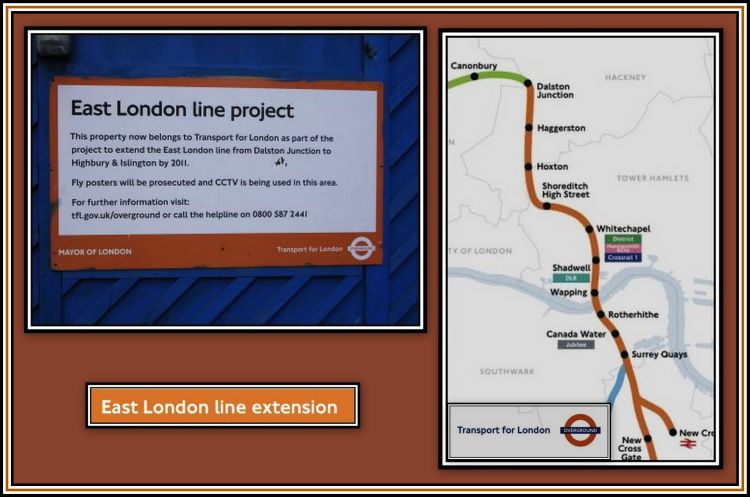 |
| |
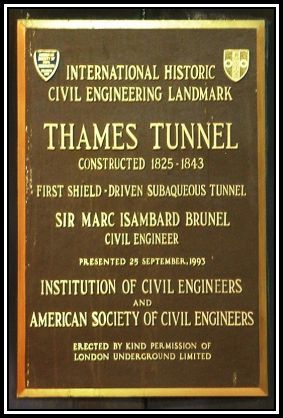 |
As of 2010, the London Underground system consisted of eleven routes or lines. There were four subsurface routes, The Circle, District, Hammersmith & City and Metropolitan lines and seven deep-tube routes, Bakerloo, Central, Jubilee, Northern, Piccadilly, Victoria and Waterloo & City lines. Until December 2007, there was a twelfth line, the East London Line, also a subsurface route, which ran north-south through the East End, Docklands and an area of South London. The line was built in 1869 and used the Thames Tunnel that was originally constructed for horse-drawn carriages by Marc Isambard Brunel. It originally formed part of the Metropolitan Line, but in 1970 it was renamed as the Metropolitan Line – East London Branch and in the 1980s it became a separate line, but still retained its union with the Metropolitan Line. In 1990 the line was given its own colour on the underground map and in 1999 an additional station was built in South London, Canada Water, had an interchange with the then-new Jubilee Line. In 2007, the line was closed for extensive rebuilding and expansion. At this time, according to Transport for London, about 10.7 million people were carried or rode the line each year. In 2010, part of the rehabilitated line was opened as the Overground network. The full network, as rail lines are apparently now called, is said to be completed soon after the 2012 Summer Olympics. |
|
| |
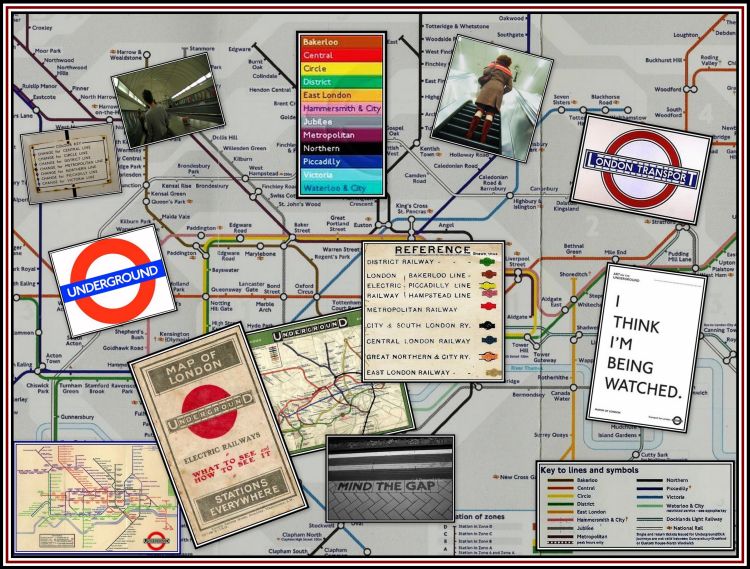 |
| |
| I remember the original East London Line well although despite living close to the Whitechapel Station, I cannot ever remember travelling on it. When I knew the line, it was had no special name and was part of the meandering mass that was once the Metropolitan Line. It ran from Shoreditch with its station on Brick Lane southwards to Whitechapel and next down to Shadwell and Wapping and then under the river to Rotherhithe and Surrey Docks and finally terminating at either New Cross or New Cross Gate. Canada Water had yet to be built. This is a distance of five miles (nine kilometres) and took about fourteen minutes to complete. Whitechapel Station is on The Waste, the street market on the Whitechapel Road in front of the London Hospital. A few shops further along the road from the station is where John Merrick, the so-called Elephant Man sat on display. |
| |
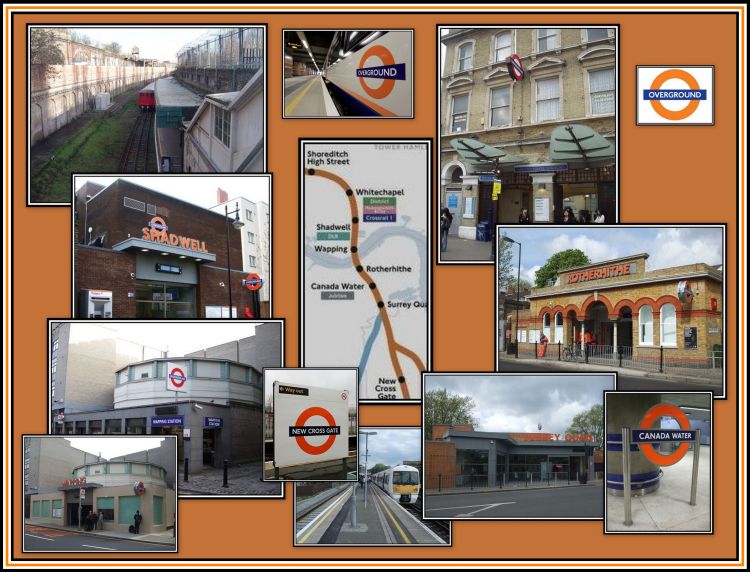 |
East London Line Stations
Left: Shoreditch High Street, Shadwell, Wapping Underground Station & the rebuilt Overground Station;
Centre: Overground train, East London Line Map, New Cross Gate Station sign & New Cross Station;
Right: Whitechapel, Rotherhithe, Surrey Quays & Canada Water sign |
| |
When I was a child, directly in front of the station was where Paul’s Record Stall stood. Paul was a great fellow and good friend of my parents. He had a music shop close to my parents’ pie ‘n’ mash shop on Cambridge Heath Road just before the Mile End Gate, as well as the stall. On Saturday afternoons I used to visit his stall and he would send me for endless cups of tea at the café close by. He used to play records constantly to attract customers and his stall was always crowded. He obviously enjoyed the music as he stood there with a cigarette constantly dangling from his mouth and with his hands buried deep in his dark blue overcoat moving his head back and forth in time with the music. Paul was very thin and always seemed to be shivering, which caused the ash from his cigarette to fall on his coat. He introduced me to rhythm ‘n’ blues and jazz and played certain tunes just to gauge my reaction. If I liked a tune, I used to bob my head in time with the beat and this would cause Paul to break into fits of laughter, which induced bouts of coughing causing ash to fly everywhere. Thanks to him I was scolded severely at my first school. After hearing the music of Louis Jordan at the stall, I became an immediate fan. Much to Paul’s amusement, and with his encouragement, I quickly learned the words of several songs and began to strut about the place singing them. One day at school, I forgot where I was and began bopping along the hallways singing Is you is or is you ain’t my baby? One of the teachers caught me in mid-bop and was appalled at what she saw and heard. I was given a letter to bring home with the request that I be discouraged from listening to such music in the future. Paul and my father found this highly amusing while my mother did not.
|
| |
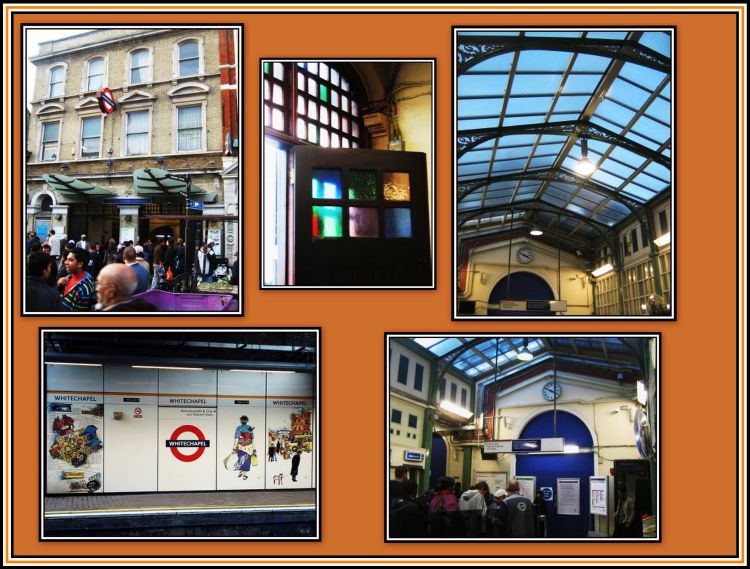 |
Whitechapel Overground/Underground Station |
| |
| One of the new stations forming part of the new East London Line, which now formed part of the Overland, is Dalston Junction. The site of the Plaza where as a child I had spent part of a number of perfect days and where the one-time Oxfam Shop-cum-snooker hall had replaced it was obviously found to be perfect once more. This time however the site was deemed perfect as an entrance to the new station. As a result, the site was required to be cleared and once the wrecking ball had brought down the building and the rubble was cleared, the site was ready for reconstruction. |
| |
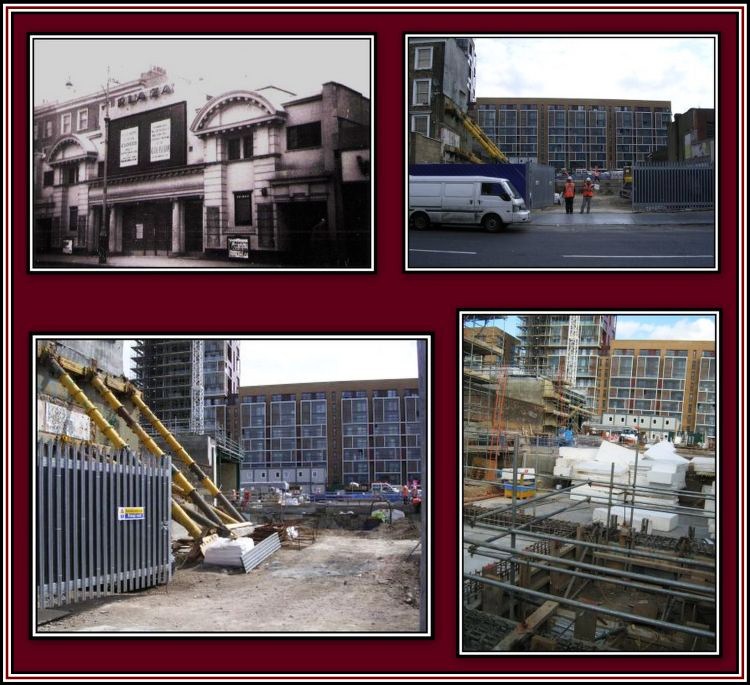 |
| |
| As I stood looking at the notice, the gates suddenly swung open and revealed the site in all its emptiness. Everything had indeed been cleared. There was nothing left of the building. It was as if the cinema, the shop and the snooker hall had never existed. I suspected that were I to ask the passersby if they knew where the Plaza had once stood, no one would know. Just like Dawson’s, it was now a place long since forgotten. |
| |
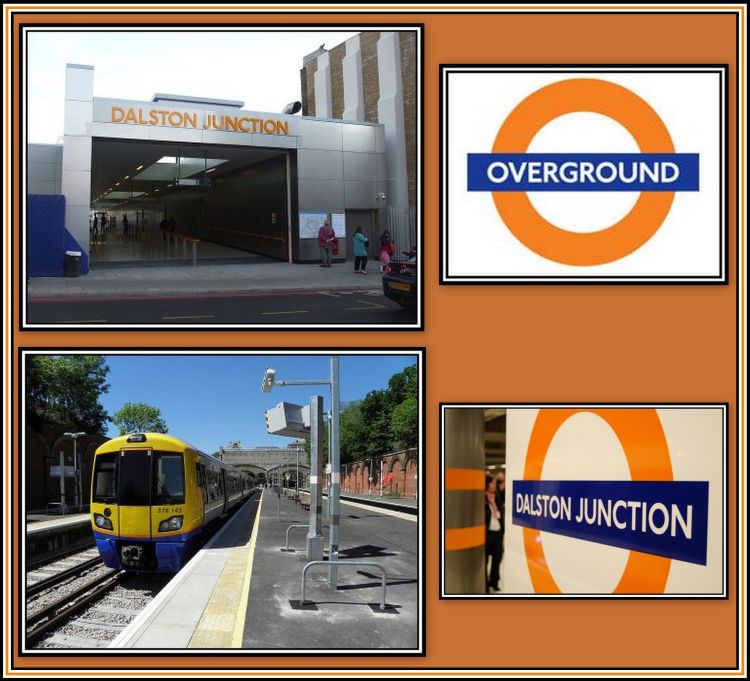 |
| |
After a while, I realized that there was no point in my remaining here. The Plaza was gone. The shop was gone and soon the site would be busy with people rushing to and from various places. And then I remembered that I had come to Dalston to find the Rio and that it was time to move on.
Somehow I had managed to miss seeing the Rio cinema when I was a child. In fact not only had I not seen it, I had never even heard of it until recently. I was told that the cinema was on the left hand side of Kingsland Road, some 200 yards or so beyond Ridley Road. To be honest, it is not surprising that I had never seen the Rio, as I had never been this far along Kingsland Road before. Well, this was not entirely true for I obviously had passed by it once when I went to Edmonton, but evidently had not noticed it at that time.
And so I turned away from the construction site and set about finding the Rio. I found it easily and seeing it cheered me up after my earlier surprises. The Rio was much bigger than I expected and proved to be a fine looking building. Fortunately it had avoided being converted into a multi-screen cinema. Unfortunately it was not open for business when I saw it so I had no chance of looking inside. An additional visit was in order, but this would have to wait for another time. Maybe when I did visit it, I should perhaps dine at the Chinese restaurant afterwards. Who knows, this could be the beginning of yet another perfect day. |
| |
 |
| |
|
|
|
|
|
|